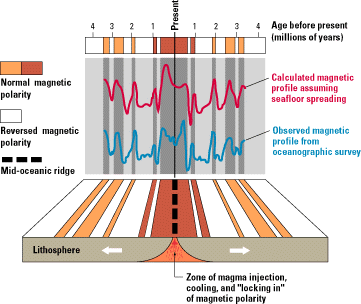
Beam me to Planet Gore !
I am cautious about believing anything I see on TV.
I think man’s warlike activities also had a lot to do with the Sahara being desert.
I saw that show too. It also mentioned that Mars’ moon is much too small to stabilize it and its axis moves all over the place. Yet in other shows they have no problem talking about terraforming Mars into a planet with plants, water, atmosphere and all the rest. But it’s clear that it can’t be done with the poles wandering all over the place.
I worry a lot about Guam tipping over.
Please, show me proof.
Yes, the Sunspot Cycle does affect weather variability. Fact. Known for 100+ years. Weather is more variable during sunspot minimums and maximums. But much of "known climate science" is pure hogwash.
Yes, the Earths axial tilt varies from about 22 degrees to 27 degrees about every 40,000 years, IIRC.
Lemme check my Flammarions...
Everyone, do not panic. The earth’s axis precesses http://en.wikipedia.org/wiki/Axial_precession_(astronomy) in a cycle that is about 25,000 years. That is what drives the changes in the astrological ages, like from Pisces to the Age of Aquarius, which, as we all remeber from the song, we are in the dawn of. The axis tilt is what gives us winter and summer, so it would make sense that the wobble around the axis would also affect climate.
I saw something similar awhile back. Not sure if this was the program, but this is what I found on You Tube:
The effect the Moon has on the Earth’s climate
http://www.youtube.com/watch?v=zWXGvlDSYFA
Here’s another one:
Life on earth without the moon - History Channel (The Universe series)
http://www.youtube.com/watch?v=6j43GCAHAHo&;
“...about the moon and the important role it plays on stabilizing earth.”
Not related to climate (I don’t think!?) - but I also imagine the world would be quite a bit different without tidal action (obviously the various creatures, but a “cleansing” action of near shore areas, movement of nutrients, etc.)
I also find it interesting that the moon is the exact size, and the sun is the exact size, and the distance from the moon to earth is exact, and the distance from the moon to sun is exact - so that we have the pleasure of solar eclipses. Plus all of the science that we have obtained from those eclipses.
And not sure how much it aids in any science, and doubt it has any role to play on our environment - but also interesting that the rate of rotation of the moon is the rate as it transits earth - so we never get to see the far side of the moon.
But all just coincidences.
Psalm 8:3
When I consider your heavens, the work of your fingers, the moon and the stars, which you have ordained...
I thought the variation in the earth’s tilt was only +/- 1 degree, 22° 38’ to 24° 21’, with an nice periodic sway. Changes in the tilt do not change the total amount of sunlight incident on earth, just the depth of the seasons. There are several variables connected to the earth’s orbit and orientation that effect climate, refered to as Milankovitch cycles. http://en.wikipedia.org/wiki/Milankovitch_cycles
For the variablity in the tilt, look here: http://en.wikipedia.org/wiki/Axial_tilt#Long_period_variations
I think the actual universe is interesting and intriguing enough that is does not need to be embellished or sensationalized.

Do people ever think about statements like this?
So let's see. There used to be lots of green plants growing in something. Was it sand? Where did the sand come from? The plants died because the climate supposedly changed. I guess it got warmer and the rain stopped. Well, it's pretty warm around the equator in the Americas which is now feeling the brunt of these supposed tilt changes, but it's hot there and it rains a lot. (and trees too, but little sand) There are obviously a lot of factors in local rainfall amounts but terrain and proximity to the oceans are two biggies that would have nothing to do with tilt changes.
ML/NJ
 The above & below is a post from a NASA website. The shift is normal and it happens on the sun every11 year solar cycle.
The above & below is a post from a NASA website. The shift is normal and it happens on the sun every11 year solar cycle. 
What causes the 100,000 year cycles of ice ages is the orbital eccentricity of the Earth.
Another important thing to consider is that Earth has been able to maintain a climate due to the magnetic shield being produced by this constant rotation and thereby keeping our atmosphere in tact.
Now consider the nearest planet to Earth, Mars has 2 moons. There is evidence that Mars once had a climate as well. It is being speculated that Mars experienced a fateful impact which changed it’s rotation. It has a distinct wobble, there is no complete magnetic shield protecting it from the solar winds that blew away its atmosphere into the cosmos.
New NASA Probe on its Way to Mars
http://www.thenewamerican.com/tech-mainmenu-30/space/9961-new-nasa-probe-on-its-way-to-mars
Man’s impact on the climate is insignificant. This will become obvious to future generations when they discover that no matter what they try, they can’t stop glaciers from recovering the northern hemisphere. Someday there will be a generation of Americans screaming they were lied to by our generation, while sniveling with influenza 8 months out of the year and Detroit buried under a half mile of glacial ice.
“You mean, we can’t cause a rise in global tmperature?”
“No dillweed, the jackwipes lied to your great, great grandparents.”